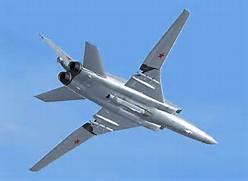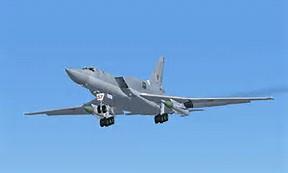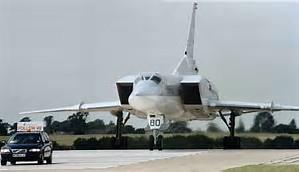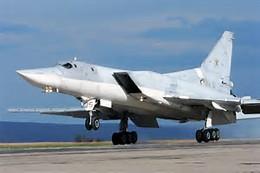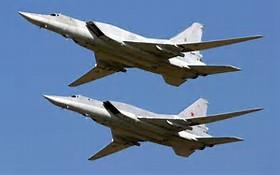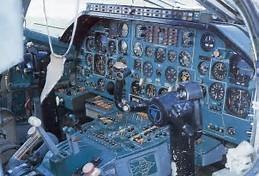S'sonic
Stealth
Menu
A free template by Lucknowwebs.com for WYSIWYG WebBuilder 8
Powered by Sispro1-S
Nigel G Wilcox
Paragon Of Space Publication
© Copyright Reserved - United Kingdom
Ideal Screen Composition 1024 x 768
SITEMAP
PSEUDO SCIENCE
SCIENCE RESEARCH
ABOUT
Desk
Supersonic
Stealth
Study
Menu
MAIN INDEX
Fastest Air Planes
Space
Transport
Menu
TU 22M Backfire
The Tupolev Tu-22M is a supersonic, variable-sweep wing, long-range strategic and maritime strike bomber developed by the Tupolev Design Bureau. According to some sources, the bomber was believed to be designated Tu-26 at one time. During the Cold War, the Tu-22M was operated by the Soviet Air Force in a strategic bombing role, and by the Soviet Naval Aviation in a long-range maritime anti-shipping role. Significant numbers remain in service with the Russian Air Force, and as of 2014 more than 100 Tu-22Ms are in use.
Maximum speed: 2,300 km/h (1,429 mph) Range: 3,169 mi, Maiden flight: 30 Aug 1969 Length: 139.11 ft Wingspan: 112.53 ft
Manufacturer: Tupolev
The latest variant of the Backfire is the third generation Tu-22M3 Backfire C model, which remained in production until 1993.
The earliest origins of the Backfire were in the earlier Tu-22 Blinder, a Russian analogue to the US B-58 Hustler. Inferior to the B-58, the Soviet air staff sought a significantly more capable design. After much research and internal argument during the mid 1960s, the Tu-22M designation was allocated to a largely unique design.
The first Backfire variant was the Tu-22M-0 subtype, using an F-4 Phantom like inlet arrangement, long inlet tunnels, a variable geometry wing, and B-1A-like side by side seating, unlike the tandem Tu-22 Blinder. A pair of NK-144-22 afterburning fans, common to the Tu-144 Concord-ski were employed. The embryonic Backfire inherited the single centreline Raduga Kh-22/AS-4 Kitchen supersonic standoff missile as its primary weapon. Flight testing progressed concurrently with low rate initial production, but only 10 were built by late 1972.
Dissatisfaction with the baseline Backfire led to an extensive rework of the design, under the designation Tu-22M-1 or Backfire A. Aerodynamics were refined, 6,500 lb of weight removed, span was increased by 60 inches and the speedbrake was relocated. The Backfire A was also a disappointment, and only 9 were built by late 1972.
Yet another cycle of redesign work followed, producing the Tu-22M-2 or Backfire B designated article 45-02, the first mass production variant. It was around 3,000 lb lighter than the Backfire A, and powered by a pair of new NK-22 engines. With more thrust, the Backfire B could lift up to 24 tonnes of weapons, including a payload of three Kh-22/AS-4 Kitchen missiles. The aircraft carried a tail turret with paired NR-23 guns, a PRS-3 Argon-2 ranging radar and TV remote gunsight. The PNA-B Rubin / Down Beat attack radar was designed to provide over 300 degree coverage emulating the HP Victor installation, and was supplemented by a ventral remote TV bombsight arranged like that in the Avro Vulcan. Dal'naya Aviatsia IOC was achieved in 1974, with AV-MF naval aviation regiments receiving their Backfire Bs in 1976. By the end of production in 1983, no less than 211 examples were built.
The Tu-22M3 remains numerically the most important bomber in the Russian air force's Long-Range Air Army inventory, and serves with seven regiments (one of which also operates Tu-22M-2s). The Naval Aviation Forces have about 80 Tu-22Ms, mostly M-3 models, split equally between divisions subordinated to the Northern and Pacific Fleets. The Naval Aviation Forces also have 12 M-3s converted as Tu-22MR reconnaissance aircraft, and reportedly also operates limited numbers of recce-configured Tu-22M2Rs.
"The aircraft is primarily used to conduct nuclear strike and conventional attack operations."
Tupolev Tu-22M design
The Tupolev Tu-22M incorporates a long variable sweep wing fuselage design. The aircraft features a stepped cockpit and variable-geometry outer wing panels. The tail fin is swept-back and tapered with a square tip. The flats mounted on the centre of body are pointed with blunt tips and each wing includes a centre section and two outer panels. The outer wings are attached to the centre section through hinged joints.
Tu-22M3 has a length of 42.4m, maximum wing span of 34.2m, and a height of 11.05m. The empty weight and maximum takeoff weights of the aircraft are 53,500kg and 126,400kg respectively.
The semi-glass cockpit accommodates a crew of four on upward-firing ejection seats. It is equipped with dedicated panels for pilots, navigator-operator and commander, with entry provided through individual doors. The pressurised cockpit is equipped with climate control systems.
Sensors / radars
The aircraft is fitted with PN-A/PN-AD bombing-navigation radar system, Argon-2 radar fire-control system and a TV-based backup optical bomb sight. The countermeasures are provided by a radar warning receiver, radio-frequency jammers, and updated defensive countermeasures gear.
Engines and landing gear
"The aircraft is equipped with tricycle landing gear to support operations on unprepared runways."
The Tu-22M3 is powered by two Kuznetsov NK-25 turbofan engines installed in the body with large air intakes and dual exhausts. Each engine produces a maximum thrust of 25,000kg and delivers an improved fuel economy.
The aircraft is equipped with tricycle landing gear to support operations on unprepared runways. The nose gear includes backward retractable twin wheels. Each main landing gear unit consists of six wheels in a 2x3 bogie arrangement. These are retracted straight in to the fuselage. The Tu-22M2 was equipped with twin brake slides and a runway arresting hook.
Performance of the Tu-22M3
The Tu-22M3 can fly at a maximum altitude of 14,000m and the rate of climb of the aircraft is 15m/s. The aircraft has a cruise speed of 900km/h and maximum speed of 2,300km/h. The operational range of the aircraft is 7,000km.
The aircraft can be equipped with refuelling probes to allow in-flight refuelling for extended range.
General characteristics
Crew: 4 (pilot, co-pilot, navigator, weapon systems officer)
Length: 42.4 m (139 ft 4 in)
Wingspan:
Spread (20° sweep): 34.28 m (112 ft 6 in)
Swept (65° sweep): 23.30 m (76 ft 6 in)
Height: 11.05 m (36 ft 3 in)
Wing area:
Spread: 183.6 m² (1,976 ft²)
Swept: 175.8 m² (1,892 ft²)
Empty weight: 58,000 kg (128,000 lb)
Loaded weight: 112,000 kg (246,000 lb)
Max. takeoff weight: 124,000 kg (273,000 lb) ; 126,400 kg (278,700 lb) for rocket assisted TO
Fuel capacity: 54,000 kg (118,800 lb) internally
Powerplant: 2 × Kuznetsov NK-25 turbofans, 247.9 kN (55,100 lbf) each
Performance
Maximum speed: Mach 1.88 (2,050 km/h; 1,110 kn; 1,280 mph) at altitude (9,140 m (30,000 ft))
Range: 6,800 km (4,200 mi; 3,700 nmi)
Combat radius: 2,410 km (1,500 mi; 1,300 nmi) with typical weapons load
Service ceiling: 13,300 m (43,600 ft)
Rate of climb: 15 m/s (2,950 ft/min)
Wing loading: 688 kg/m² (147 lb/ft²)
Thrust/weight: 0.45
Armament
Guns: 1 × 23-mm GSh-23 cannon in remotely controlled tail turret
Hardpoints: wing and fuselage pylons and internal weapons bay with a capacity of 24,000 kg (53,000 lb) of
Up to 3 × Kh-22/Kh-32 missiles in weapons bay and on wing pylons or
Up to 6 × Kh-15 missiles on a MKU-6-1 rotary launcher in its bomb bay, plus 4 × Raduga Kh-15 missiles on two underwing pylons for a total of 10 missiles per aircraft.
Various sea mines and freefall bombs - 69 × FAB-250 or 8 × FAB-1500 might be typical.
The Kh-55 (AS-15 Kent) long-range cruise missile was tested on the Tu-22M but apparently not used in service.
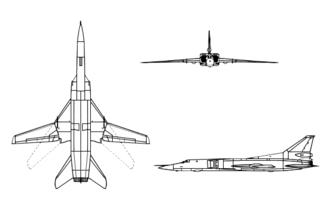
Role: Strategic bomber/Maritime strike
Manufacturer: Tupolev
First flight: 30 August 1969
Introduction: 1972
Status: In service
Primary users: Soviet Air Forces (historical)
Russian Air Force
Ukrainian Air Force
Produced: 1967-1997
Number built: 497
Developed from: Tupolev Tu-22




